Content is king. But with a crown comes great responsibility.
To ensure your content reigns supreme, you must measure its performance.
That’s where content marketing metrics come in.
They’re the compass that guides your content strategy, helping you navigate the vast ocean of online information and reach your desired shores.
The recent research of HubSpot states that 82% of marketers actively invest in content marketing.
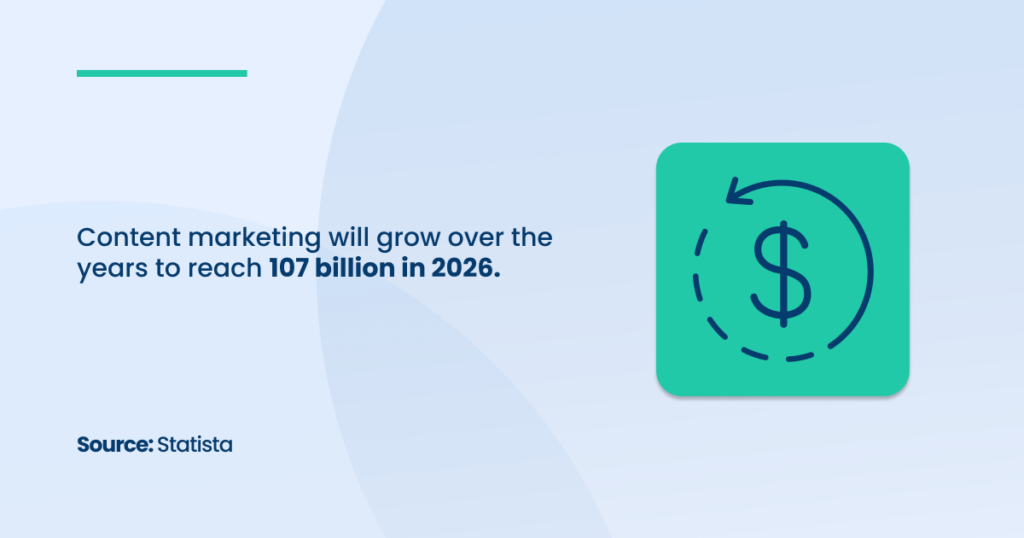
The increasing demand for content marketing is driven by businesses recognizing its power to build brand authority, engage audiences, and drive long-term growth in a competitive digital landscape.
By partnering with an expert content marketing agency, businesses can leverage expert strategies to create high-quality and engaging content.
The blog post will explore the world of content marketing metrics and discover how they can help you create quality content.
Website Traffic
Website traffic is one of the most crucial metrics to track in content marketing.
The number of visitors who come to your website reflects the effectiveness of your content marketing efforts in reaching and engaging your target audience.
Forbes highlights that 51% of content consumption comes from organic search.
A steady increase in traffic is often a key indicator of content marketing success and reflects a solid content marketing strategy.
Why Website Traffic Matters for Content Marketing
Understanding the significance of website traffic is fundamental for businesses looking to succeed in their content marketing efforts.
It’s not just about attracting visitors; it’s about bringing the right visitors to your site—those who are genuinely interested in your product or service and likely to convert.
1. Reflects Audience Engagement and Interest
High website traffic signals that your content is resonating with your target audience. If people are coming to your website in large numbers, your content marketing efforts effectively grab attention and generate interest.
By analyzing content marketing stats, businesses can gain valuable insights into audience behavior, campaign effectiveness, and areas for improvement to enhance their overall strategy.
When your content addresses your audience’s pain points and needs, you’ll naturally see an uptick in traffic.
This engagement can lead to higher conversions, making traffic a primary content marketing success metric to monitor.
2. Supports Lead Generation
Your content should drive traffic and move visitors through your marketing funnel, ultimately converting them into leads or customers.
Increased traffic from high-quality content results in more opportunities for conversion, turning casual visitors into loyal customers.
Tracking content marketing metrics such as visitor behavior and engagement on landing pages allows you to refine your content marketing strategy for better lead generation.
3. Improves SEO Rankings
Website traffic plays a direct role in your SEO rankings.
Source: Forbes
Search engines like Google consider traffic as an important ranking factor.
When your content attracts more visitors, especially with other marketing success metrics like low bounce rates and long session durations, it signals to search engines that your website provides valuable content.
This boosts your SEO performance, driving even more organic traffic in a growth cycle.
Engagement Metrics to Track
To ensure the effectiveness of your content marketing strategy, it’s important to focus on specific engagement metrics that provide actionable insights.
These content marketing success metrics help you understand user behavior, identify areas for improvement, and adjust your strategy accordingly.
Among the most important engagement metrics are bounce rate, average session duration, and pages per session—all of which are readily available through tools like Google Analytics.
Bounce Rate
Bounce rate is one of the most telling content marketing metrics for measuring audience engagement. It refers to the percentage of visitors who land on a page on your website and then leave without interacting further, such as clicking on another page or taking any desired action.
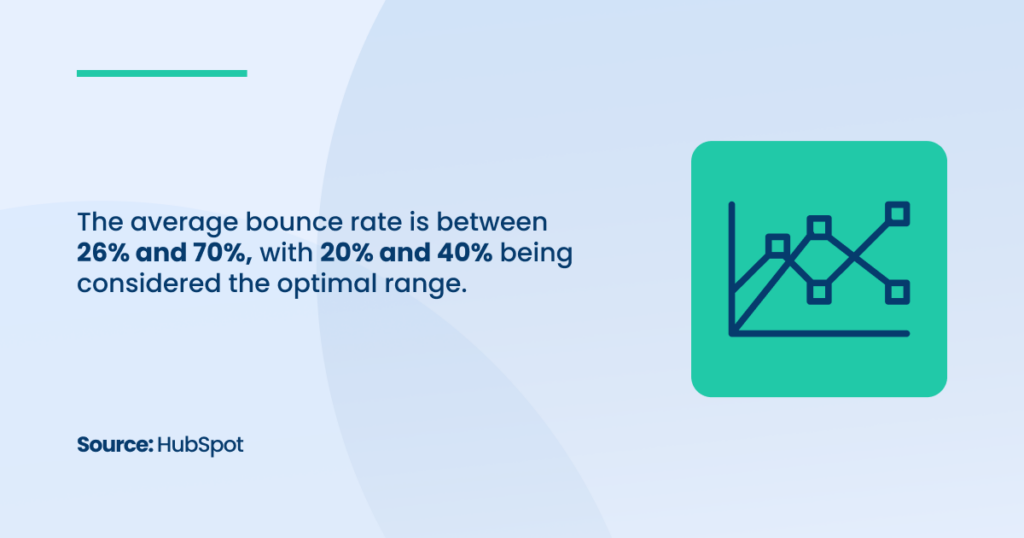
A high bounce rate indicates that visitors are not finding the content engaging or relevant, which can negatively affect your content marketing success.
Why Bounce Rate Matters
A high bounce rate can signal that your content is not meeting visitors’ expectations or that the user experience is suboptimal.
For example, if users are landing on your website from search engine results pages but leave almost immediately, it suggests that your content doesn’t align with their search intent or the page layout and design aren’t user-friendly.
A low bounce rate, on the other hand, indicates that your visitors are finding value in your content and are likely to explore it further.
How to Improve Bounce Rate
Improving your bounce rate requires optimizing content, design, and user experience.
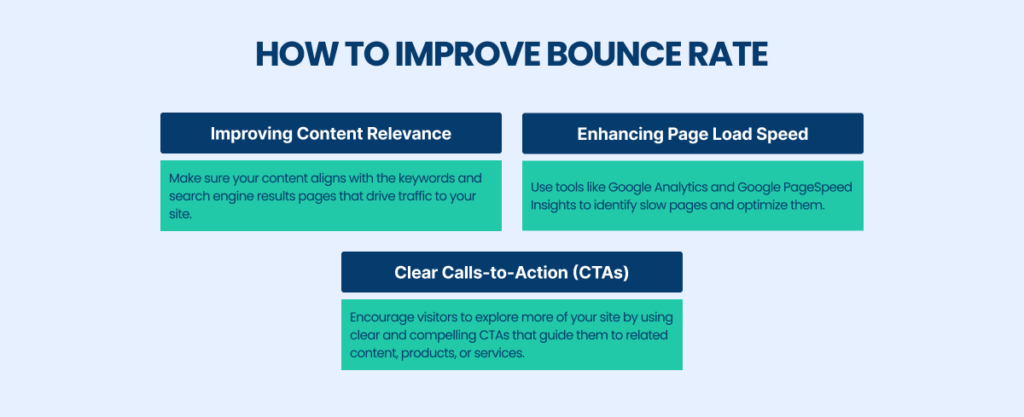
Bounce rate is a key metric in content marketing because it provides direct feedback on the quality of your content and user experience. By reducing bounce rates, you increase the likelihood of visitors staying longer and interacting more with your site.
Average Session Duration
Average session duration is the average time a visitor spends on your website during a session. This metric helps you understand how engaged users are with your content.
If visitors spend considerable time on your site, it indicates that your content is holding their attention. On the other hand, short session durations could imply that your content isn’t engaging enough to keep visitors interested.
Conversion Rates
The conversion rate for a website averages 2.35%. Conversion rates are one of the most important content marketing metrics for any business aiming to turn visitors into leads or customers.
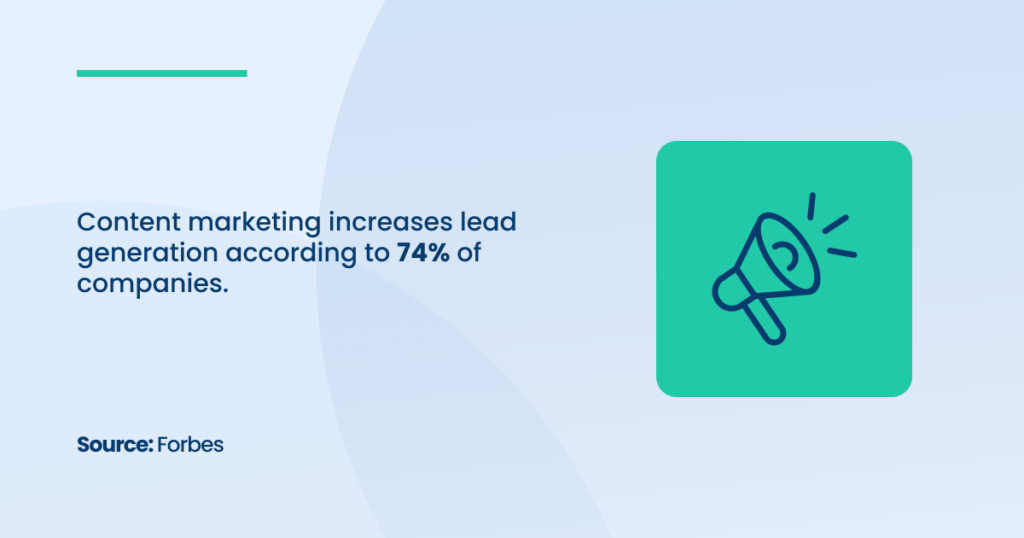
While driving traffic to your website is crucial, converting that traffic into tangible outcomes is what defines content marketing success.
Source: Enterprise Today
Tracking and optimizing conversion rates helps ensure that your content marketing efforts not only attract the right audience but also guide them through the customer journey to complete an action.
Why Conversion Rates Matter
Conversion rates are critical because they indicate how effective your content is at driving valuable actions from your audience.
If you’re attracting a lot of traffic but your conversion rates are low, it could signal a disconnect between your content and the audience’s expectations or needs.
Conversely, high conversion rates show that your content marketing efforts resonate with visitors and guide them toward taking the desired action.
Tracking conversion rates is essential for improving your overall content marketing strategy. It allows you to see which pieces of content are most effective at turning visitors into customers and helps you understand where improvements are needed.
By analyzing conversion rates alongside other content marketing success metrics, you can make data-driven decisions to enhance your content’s performance.
Types of Content-Driven Conversions
Depending on your business goals, content-driven conversions can take many forms, including:
- Sales Conversions: When a visitor completes a purchase after engaging with your content, such as a product page or blog post.
- Lead Generation: When a visitor fills out a form, subscribes to a newsletter, or signs up for a free trial based on your content.
- Engagement Conversions occur when a visitor takes actions that signal deeper engagement, such as downloading a whitepaper or sharing a blog post.
By identifying the specific type of conversion you want to achieve, you can tailor your content marketing efforts to encourage those actions.
Social Media Metrics
In today’s digital marketing landscape, social media is pivotal in driving engagement, brand awareness, and conversions.
Monitoring the right social media metrics is essential to understanding the success of your content marketing strategy and ensuring that your content marketing efforts are aligned with your business goals.
These metrics help you measure how your audience interacts with your content, how well your campaigns perform, and how your brand is growing on social platforms.
Just like tracking content marketing metrics on your website, analyzing your social media performance is crucial for evaluating content marketing success metrics.
With the right social media metrics in place, you can understand what resonates with your audience and how to refine your strategy for better results.
Likes, Shares, and Comments
Engagement metrics like likes, shares, and comments are among social media platforms’ most basic but essential content marketing metrics.
These actions reflect how well your audience connects with your content and indicate the level of interaction and interest.
- Likes show that users appreciate your content, offering a basic measure of approval.
- Shares are even more valuable, as they indicate that users find your content compelling enough to share with their network, expanding your reach.
- Comments provide an opportunity for deeper interaction, showing that users are willing to engage in a conversation with your brand or others in the community.
How to Improve Engagement Metrics
To improve engagement metrics like likes, shares, and comments, consider these strategies.
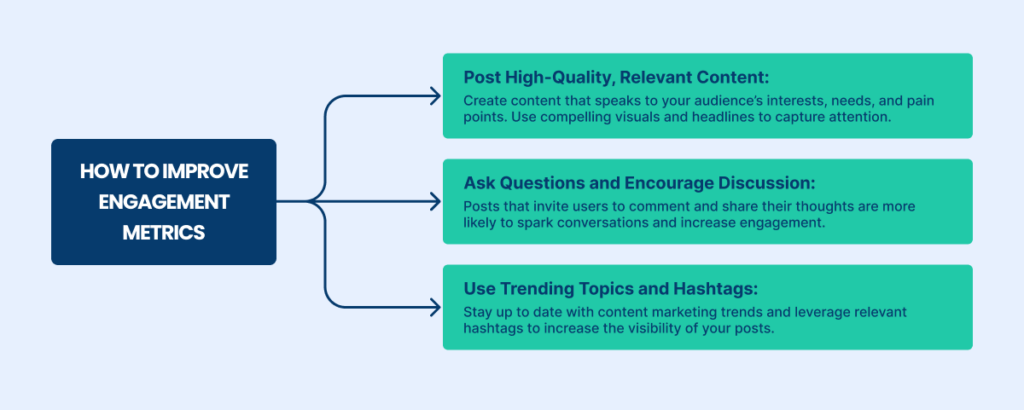
Tracking engagement metrics is an essential part of content marketing measurement, helping you fine-tune your strategy to improve audience interaction and build stronger relationships with your followers.
Follower Growth
Follower growth measures the increase (or decrease) in the number of people who follow your social media profiles over time.
This metric is critical for understanding how your brand’s presence is expanding on social platforms and whether your content is attracting new audiences.
Follower growth is one of the most visible signs of content marketing success on social media.
A steady increase in followers indicates that your content and brand messaging are resonating with your target audience, while stagnant or declining follower numbers may signal that your content needs adjustment.
Why Follower Growth Matters
Growing your follower base is important because a larger audience increases the potential reach of your content.
More followers mean more people will see, engage with, and potentially share your content, which in turn drives more traffic to your website and increases your brand’s visibility.
Additionally, follower growth can influence your performance in keyword rankings and search engine results pages (SERPs).
Social signals, such as follower count and engagement rates, can indirectly impact your SEO efforts by driving more traffic to your site, which search engines take into account when ranking pages.
How to Improve Follower Growth
Here are some strategies to boost your follower growth:
- Create Consistent, High-Quality Content: Posting regularly and delivering valuable content helps keep your audience engaged and encourages new followers to join.
- Collaborate with Influencers: Partnering with influencers in your niche can help expose your brand to a larger, more targeted audience, driving new followers to your account.
- Run Social Media Campaigns: Contests, giveaways, and special promotions are great ways to attract new followers and incentivize users to engage with your brand.
Follower growth is a key metric in content marketing measurement because it reflects the expanding reach of your brand and its ability to attract and retain an audience.
Click-Through Rates (CTR)
Click-through rate (CTR) measures the percentage of users who click on a link in your social media post compared to the total number of people who saw the post.
This metric is critical for understanding how well your social media content drives traffic to your website, landing pages, or other digital assets.
Source: Average Click-Through Rate by Industry, Word Stream
CTR is an important part of content marketing measurement because it indicates how effectively your content motivates users to take action, such as visiting your website, reading a blog post, or making a purchase.
How to Improve CTR
To improve your CTR on social media, consider these tactics:
- Craft Compelling Headlines: Your headline or post caption is often the first thing users see. Make sure it’s engaging, clear, and encourages users to take action.
- Use Strong Calls-to-Action (CTAs): A well-placed, persuasive CTA can significantly increase your CTR. Encourage users to click the link to learn more, sign up, or explore further.
- Optimize Visuals: Posts with eye-catching images or videos are more likely to capture attention and prompt users to click through.
Improving your CTR is essential for driving more traffic from social media to your website and converting that traffic into leads or customers.
SEO Performance
Search engine optimization (SEO) is one of the most important factors in achieving content marketing success.
Your content’s performance on search engines directly impacts how much traffic you drive to your website, influencing conversions and business growth.

To evaluate the effectiveness of your SEO efforts, it’s crucial to monitor key content marketing metrics that indicate how well your content ranks and performs on search engines.
Tracking these SEO performance metrics provides valuable insights into the success of your content marketing program and helps identify areas for improvement.
SEO Metrics to Track for Content Success
To ensure your content marketing efforts are yielding the best possible results, it’s important to focus on specific SEO metrics that reveal how well your content is optimized for search engines.
These content marketing metrics include organic traffic, keyword rankings, and backlink growth—all of which can be measured using tools like Google Search Console and SEO dashboards.
By monitoring these metrics, you can refine your SEO strategy to drive more traffic, improve visibility in search engine results pages (SERPs), and enhance the overall effectiveness of your content marketing program.
Organic Traffic
Organic traffic refers to the visitors who arrive at your website through unpaid search engine results. This metric is a direct reflection of how well your website and content are optimized for search engines.
The more optimized your content is for relevant search queries, the higher your chances of attracting organic traffic.
Organic traffic is one of the most crucial content marketing success metrics because it signifies that your content is ranking well for keywords that align with your audience’s search intent.
Unlike paid traffic, organic traffic continues to grow as long as your content remains relevant and optimized for SEO.
Keyword Rankings
Keyword rankings refer to your website’s position in search engine results for specific search terms.

Monitoring keyword rankings is a core part of content marketing measurement because it shows how well your content is performing in terms of visibility for targeted keywords.
Higher keyword rankings mean your content is more likely to be seen by users searching for those terms, which translates to more traffic.
Backlink Growth
Backlink growth refers to the number of external websites that link to your content. Backlinks are one of the most significant ranking factors in SEO, as they signal to search engines that your content is authoritative and trustworthy.
The more high-quality backlinks your content receives, the better your chances of ranking higher in search engine results pages (SERPs).
Why Backlink Growth Matters
Backlinks serve as endorsements from other websites, which boosts your site’s credibility in the eyes of search engines.
A robust backlink profile is one of the most important content marketing success metrics because it directly impacts your website’s authority, visibility, and organic rankings.
Backlinks also help drive referral traffic, as users who click on a link to your site from another website are directed to your content. This not only increases your traffic but also exposes your brand to new audiences, enhancing your overall content marketing program.
How to Improve Backlink Growth
Here are some strategies for improving backlink growth:
- Create High-Quality, Shareable Content: The best way to attract backlinks is to publish content that is valuable, informative, and shareable. Content such as guides, research studies, and infographics tends to attract more backlinks.
- Outreach to Industry Influencers: Building relationships with influencers and other reputable websites in your industry can help you earn backlinks. Share your content with them, and if they find it valuable, they may link back to it.
- Guest Blogging: Writing guest posts for other websites in your niche is another way to build backlinks. In exchange for contributing valuable content to another site, you can include links back to your own content.
Partner with [A] Growth Agency to Enhance Your Content Marketing Metrics
Content marketing metrics are the backbone of a successful content strategy.
Remember, the content marketing journey is continuous. By regularly monitoring and adjusting your metrics, you can ensure your content remains relevant, engaging, and effective.
[A] Growth Agency will accomplish your dreams.
Our experienced team believes in the power of data to inform and drive every strategy, ensuring our actions are as effective as they are innovative.
Moreover, growth isn’t just what we offer. It’s who we are.
We don’t just follow content marketing trends – we set them, continuously refining our strategies to stay ahead of the curve.

